こんにちは、デザイン部の榛葉です。
今回のテーマは、誰でも名前くらいは聞いたことがあるだろうデンマークという国のデザイン文化についてお話しようと思う。建築物から家具、食器などのすばらしいデザインがあふれる国の、デザイン大国と呼ばれる魅力的な文化の所以について紹介したい。
そもそもデンマークってどんな国?
デンマーク発祥のもので特に日本でも知られているものといえば、童話作家のアンデルセンやLEGOブロックだろう。国名を聞いてもあまりピンとこない方でも、それらの名前くらいは知っているはずだ。
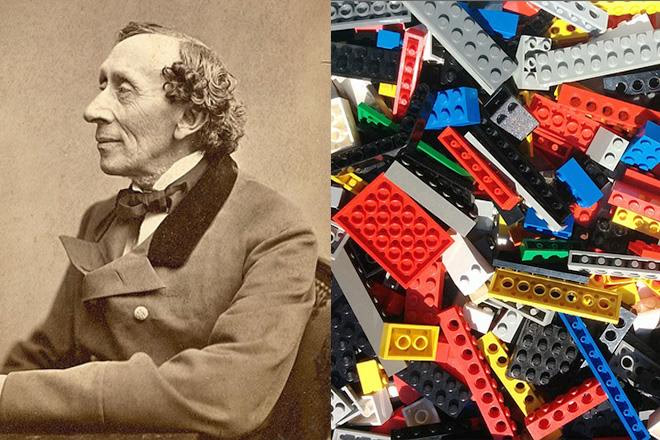
左:デンマークの代表的な童話作家、ハンス・クリスチャン・アンデルセン
右:デンマークのプラスチック製の組み立てブロック玩具のブランド、レゴ(LEGO)の代表的なパーツ
デンマークは北欧と呼ばれる地域にある。北欧とは諸説あるが、狭義の定義では、ノルウェー、フィンランド、スウェーデン、アイスランドと、デンマークのヨーロッパの北部一帯の5ヶ国のことを指す。その中で一番南に位置するデンマークは、北海道よりも北緯が上にある。半島と島々からなる九州とほぼ同じくらいの国土の国境は9割が海に面しており、そこに570万人ほどが住む世界でももっとも小さな国の一つだ。

デンマークと北欧諸国の立地
夏は涼しく日が長いため過ごしやすいが、冬は雨が多く日が短い上、とにかく寒いらしい。
福祉国家の代表格として、貧富の格差が小さく、男女平等の施策がいち早く進められ、企業の福利厚生も充実するなど、その仕組みは多くの国家のモデルにもなるほど。税率が超高割合ではあるのだが、そのぶん小学校から大学までの教育費や、生涯の医療費を国がすべて負担してくれるという高福祉高負担国家だ。
それに伴い、国民の所得格差が世界でもっとも小さく、市民の生活満足度は高い。国連が毎年発表する国民の幸福度ランキングでは常に上位に入り、2016年は対象の155ヶ国で1位、2017年も隣国ノルウェーに僅差で続いて2位になるなど、世界一幸せな国と呼ばれている。ちなみに、日本は51位となかなか厳しい結果である。
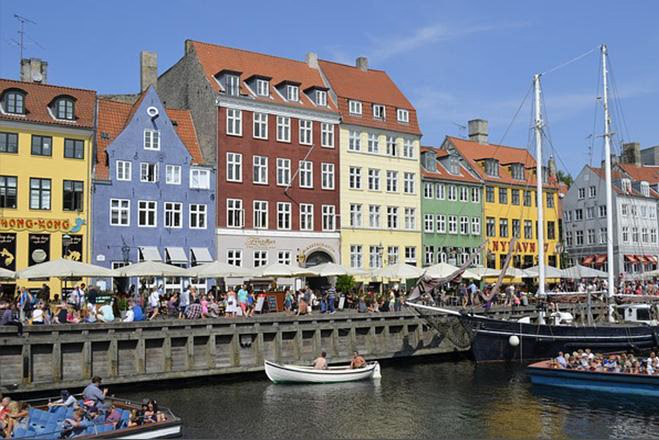
デンマークの首都コペンハーゲンの風景
北欧といえば、なんといってもインテリアや建築、ランドスケープ・デザインが素晴らしい。日本でもインテリアや雑貨でお馴染みのIKEA(イケア)はスウェーデン、ファブリックで人気のMarimekko(マリメッコ)はフィンランドなど、シンプル・モダンやオーガニック・モダンデザインの聖地である。
私が北欧諸国の中でも特にデンマークへ興味が止まらないのには、主に3つの理由がある。素晴らしいインダストリアル・デザインが文化として国民に浸透していることや、それらの文化発展を成し遂げた巨匠デザイナーたちが多く、その影響下での文化や思考が素晴らしいことが一つ。私生活での引越しを機に、念願のデンマーク製のデスクを手に入れ、その魅力に取り憑かれていることがもう一つ。最後に、幸福の原点となる言葉「ヒュッゲ」が示す文化の独特な魅力に感化されたことだ。
城下町静岡の都市型美術館『静岡市美術館』へ
そんな興味を抱く中、タイミングよくデンマークのデザイン展があることを知り、さっそく10月頭の週末に、静岡市美術館で開催中の『デンマーク・デザイン』展へ足を運んでみた。
JR藤沢駅から東海道線を西へ向かい、小田原でこだまに乗り替え約80分、徳川家康公ゆかりの城下町静岡市の中心、静岡駅に着く。北口を出ると、目の前に見上げるような大きく目立つ建物があるので、すぐにそこが美術館だとわかった。

JR静岡駅北口駅前ロータリーから美術館の入る建物が見える
建物に入りエスカレーターを3階まで上がると、全面白のシンプルでスッキリとした壁と高い天井の空間が広がる。富士山をモチーフにしたロゴや各所のサインも洗練された印象を与えてくれる。都内の人気の展覧会と異なり、土曜にもかかわらず館内はがらりと空いていた。カップルや夫婦、建築を学ぶ学生らしき人が数組いるだけ。混み合う美術展にうんざりしていたので、この状況に気持ちが安らぎ展覧会を楽しむ意気込みも高まった。
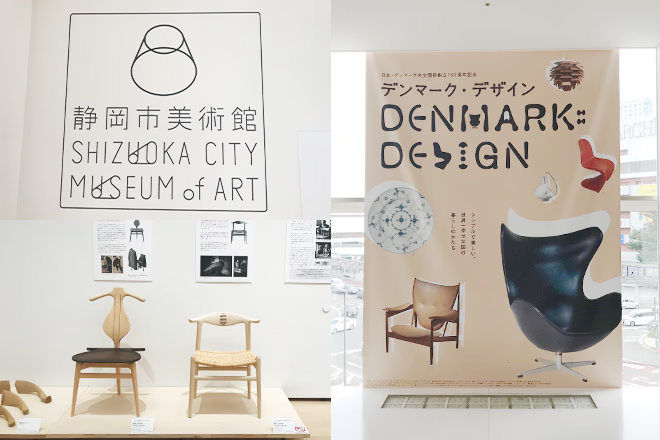
デンマーク・デザイン展を開催する静岡市美術館の館内

子供が遊べる巨大なレゴ・ブロックのコーナー『レゴソフトであそぼう!』
このデンマーク・デザイン展は、日本との修好150周年を記念した企画で、長崎から始まり、1年をかけて全国5カ所で開催される。
デンマーク・デザイン展と巨匠デザイナーたち
展覧会は、デンマーク・デザイン博物館の協力のもとで企画され、近代から現代までのデザイン史を約200点のデンマーク・デザインのプロダクトで辿るというもの。デンマークの工芸品で初めて国際評価を得たロイヤル・コペンハーゲンの食器の展示から始まり、多くの巨匠デザイナーの作品とその時代背景を並列に進んでいき、近代のデンマーク・デザインも紹介されている。最後には体験コーナーとして、巨匠がデザインした椅子に実際に座ることができたり、子供たちが巨大なレゴ・ブロックで遊べるコーナーも用意されていた。
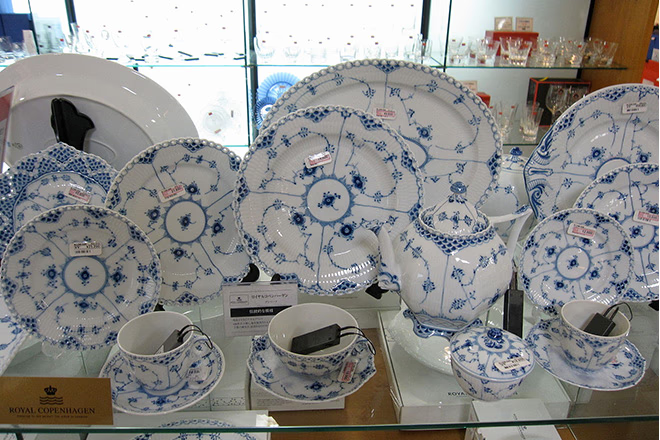
ロイヤル・コペンハーゲンの『ブルーフルーテッド』
1775年に王室からの贈り物として制作が始まって以来のロングセラー
※画像は展覧会の写真ではありません。
(Photo by Wikipedia – Change of venue(2017) / Adapted.(CC BY-SA 3.0))
その中から、特に著名で重要な1920年代の黎明期から1950年代〜60年代の黄金期に活躍し偉大な功績を残したデザイナーと、その代表作について紹介しよう。
デンマーク・モダン家具デザインの父
コーア・クリント/Kaare Klint(1888-1954)
デンマークの家具デザインに最も影響を与えた人物と言われているクリント。王立アカデミーに家具専攻科を創設、自らその教授となる。そこで学んだ生徒から、多くの世界的デザイナーが誕生している。それほど多くの作品は残していないクリントだが、斬新さや過去にとらわれないモダニズムが主流だった時代に、あえて過去の様式を見直し再構成する“リ・デザイン”を理念に掲げ、『レッドチェア』や『サファリチェア』、『フォーボーチェア』などの名作を世に残している。これらには、人間工学をもとに機能性を最大限に発揮することを追求し、過去の問題点をデザインで解決するという工程が反映されており、次世代の多くのデザイナーに影響を与えた。

左:コーア・クリントの肖像
右上:デンマーク・デザインミュージアム内に並ぶのは、
クリントがデザインした照明やデスク、名作のレッド・チェア
(Photo by Wikipedia – Change of venue(2017) / Adapted.(CC BY 2.0))
右下左:クリントがデザインしたサファリチェア
(Photo by Wikipedia – Change of venue(2017) / Adapted.(CC BY-SA 3.0))
右下右:クリントがデザインしたフォーボーチェアとデスク
(Photo by Wikipedia – Change of venue(2017) / Adapted.(CC BY 2.0))
世界初のデザインホテルを手がけた建築家
アルネ・ヤコブセン/Arne Emil Jacobsen(1902-1971)
デンマークでもっとも著名な巨匠デザイナーの一人。1960年に完成した『ラディソンSASロイヤルホテル』は、ヤコブセンの最高傑作で、建築はもちろん、家具や照明、カーペットやドアノブ、カトラリーにいたるまで、すべてのデザインを一人で手がけたことが、世界初のデザインホテルとなり世に知られている。ミッドセンチュリー・デザインの家具の中でも、とりわけ象徴的で人気も高い『エッグチェア』や『スワンチェア』は、彼がこのホテルのためにデザインしたもの。その他にも、共同住宅やガソリンスタンドのデザインも行うなど、デンマーク各地でヤコブセンのデザインを見ることができる。北欧インテリアのアイコンとも言える『セブン・チェア』は、これまでに700万脚以上のセールスを生んだ大ベストセラー・プロダクトである。

左:アルネ・ヤコブセンの肖像
右:ミッドセンチュリーの北欧デザインの代表作『セブン・チェア』
(Photo by Wikipedia – Change of venue(2017)/ Adapted.(CC BY-SA 3.0))

上:ヤコブセンデザインのガソリンスタンド
左下:1960年から今も変わらない『ラディソンSASロイヤルホテル』の606号スイート。
ヤコブセンデザインのエッグチェア、スワンチェア、ドロップチェアが並ぶ
(Photo by Wikipedia – Change of venue(2017)/ Adapted.(CC-BY-SA-4.0))
右下:ヤコブセンデザインのスワンチェアが並ぶ同ホテルのロビー
(Photo by Wikipedia – Change of venue(2017)/ Adapted.(CC BY-2.0))
デザインした椅子が500種以上という椅子の巨匠
ハンス・J・ウェグナー/Hans J Wegner(1914-2007)
歴史的な椅子の形を現代に展開する試みとして、中国明時代の椅子からインスピレーションを得て生み出された『チャイニーズ・チェア』、大統領候補ジョン・F・ケネディとリチャード・ニクソンが、CNNテレビでの討論の際に座ったことでも有名な『ザ・チェア』、デンマークを代表する家具メーカーである『カール・ハンセン&サン社(CARL HANSEN & SON)』との共同プロダクト『Y・チェア』『シェル・チェア』など、多くの名作が世に送り出されている。生涯で500種以上の椅子をデザインしたことから、椅子の巨匠として世界中に名が知られている。また、デンマーク第二の都市オルフス市の市庁舎建築プロジェクト(アルネ・ヤコブセン、エリック・ミュラーと協力/1948年完成)で家具のデザイン設計に携わるなど、デンマーク・デザイン界で重要な人物の一人とされている。
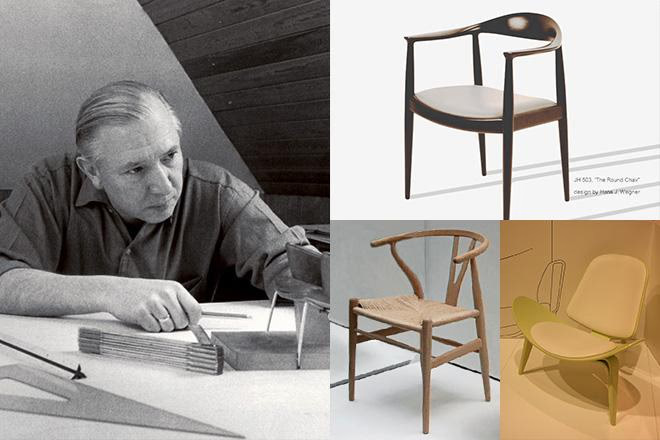
左:ハンス・J・ウェグナーの肖像
右上:ウェグナーがデザインしたザ・チェア
(Photo by Wikipedia – Change of venue(2017)/ Adapted.(CC BY-SA 3.0))
右下左:ウェグナーがデザインしたY・チェア
右下右:ウェグナーがデザインしたシェル・チェア
(Photo by Wikipedia – Change of venue(2017)/ Adapted.(CC BY-SA 2.0))
照明のデザインをはじめ、
マルチに活躍した巨匠アーティスト
ポール・ヘニングセン/Poul Henningsen(1894-1967)
建築家、デザイナーとしてだけでなく、文筆家、ジャーナリスト、文化批評家としても活躍。PH(ピー・ホー)の名で親しまれ、画家、照明デザイナー、作曲家、凧愛好家、教育者など、多才に活躍する芸術家である。特にヘニングセンがデザインしたペンダント・ランプは、デンマーク中の家庭や公共施設で今日も使用され続けている、国民に愛されるミッドセンチュリー・デザインの傑作。1925年から始まるルイス・ポールセン社(Louis Poulsen)との共同プロダクトであるペンダント・ランプの数々は、複数枚のシェードを組み合わせることで得られる柔らかな光のグラデーションや温もりが情緒的で、眩しさを抑えるなどの機能性も含む画期的なデザインであり、同社とともに100種類以上の照明を世に送り出している。
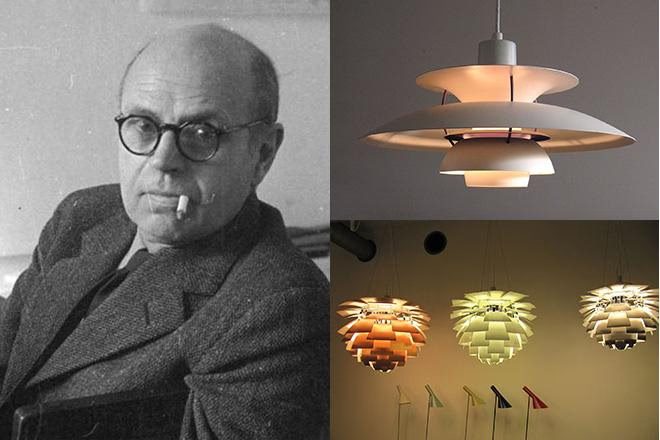
左:ポール・ヘニングセンの肖像
右上:PH5 ペンダントライト
(Photo by Wikipedia – Change of venue(2017)/ Adapted.(CC BY-SA 3.0))
右下:コペンハーゲンのランエリーニュ・パヴィリオンのために設計したペンダントライト、
通称“PH アーティチョーク”
(Photo by Wikipedia – Change of venue(2017)/ Adapted.(CC BY-SA 2.0))
デンマーク・デザイン界の異端児
フィン・ユール/Finn Juhl(1912-1989)
建築家。デンマークのモダン・デザインの本流であったコーア・クリントの影響に反した、異端のデザイナー・建築家としてその存在が認知されている。デンマーク・デザインの展覧会をニューヨークで企画したりと、デーニッシュ・モダンのアメリカへの躍進に大きく貢献した。ニューヨークにある国際連合本部ビル信託当地理事会会議場のインテリア・デザインを手がけた際には、カーテン、家具、カーペット、壁、そして色彩設計を含む細部に至るまで、完璧に統一的な視点に基づくデザインを実現させた。また、ジェット機のインテリア・デザインを手がけるなど、その活躍は多岐にわたる。彫刻的造形美を含んだ家具のデザインは、まるでアートのような美しさを含んでおり、代表作に『チーフティン・チェア』『イージー・チェア』があるが、いずれも細部の滑らかさなど、思わず触れたくなるような究極の曲線美をもつ。

左:フィン・ユールの肖像
右上:ユールがデザインしたニューヨークの国際連合本部ビル信託当地理事会会議場
(Photo by Wikipedia – Change of venue(2017)/ Adapted.(CC BY-SA 4.0))
右下:30歳の時のユール自身によってデザインし建築されたプライベートハウス“フィン・ユール邸”
(Photo by Wikipedia – Change of venue(2017)/ Adapted.(CC BY 2.0))
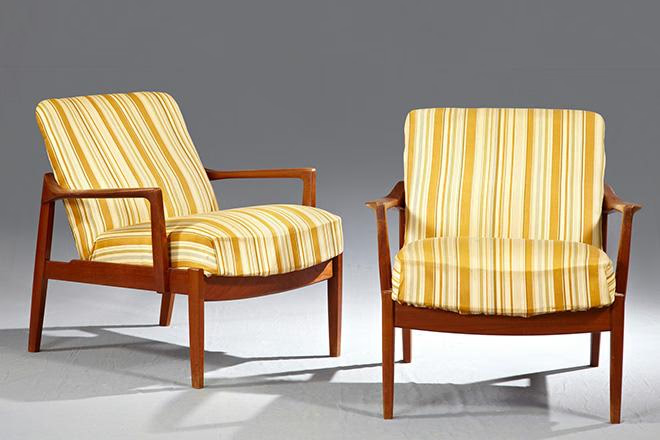
アームの曲線が美しいフィン・ユールデザインの椅子
(Photo by coffee shop soulja – Change of venue(2017)/ Adapted.(CC BY 2.0))
その他にも数多くの素晴らしいデザイナーとその作品が世に溢れているので、ぜひ興味を持った方には見て欲しい。
前編はデンマークという国の紹介、『デンマーク・デザイン』展の概要とそこで取り上げられている重要なデザイナーの一部を紹介した。
後編では、それらのデザインが愛され続ける理由、実際に購入してみたデスクについて、そしてデンマークのデザインを通して見えてきたことを紹介したいと思う。
後編につづく

